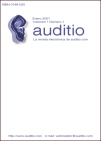Frequency modulated systems in students with cochlear implant
DOI:
https://doi.org/10.51445/sja.auditio.vol3.2006.0036Keywords:
cochlear implant, frequency modulation, Speech Audibility index, assistive devices, speech identificationAbstract
Due to the limitations of the Cochlear Implant (CI), the use of Frequency Modulated (FM) systems is advised to improve the signal-to-noise ratio in auditory-verbal learning environments in adverse acoustic conditions. Previous studies have shown that the acoustic conditions of most of the classrooms are acceptable for normal hearing students, however, these conditions are not appropriate for students with CI or other types of assistive listening devices. In this study, a simulation of the speech identification skills of a group of 1st year secondary school students is carried out based on the acoustic characteristics of the classroom. The Speech Audibility Index (AI) obtained for the analyzed classroom was 52%. From this AI, an estimate of speech perception is carried out for normal hearing students, with IC and IC + FM for the same position of the student in the classroom. Speech recognition is studied in three conditions of difficulty: (i) isolated high and low familiarity words (ii) phonemes in syllables and (iii) high and low familiarity words in simple and complex sentences. The results show that the linguistic competences of identification of the spoken message obtained by normal hearing students are higher than 92%. The estimate for students with CI showed significantly lower scores, being 34% in the recognition of novel words in complex sentences. The results obtained with IC + FM significantly improve linguistic performance, reaching 80% in the recognition of novel words in complex sentences. This study shows the acoustic barriers of the analyzed classroom for students with HF and the advantages of using FM systems.
Downloads
Visibility and Altmetrics
Metrics
Global Statistics ℹ️
|
1354
Views
|
749
Downloads
|
|
2103
Total
|
|
References
Crandell, C., & Smaldino, J. (2000) Room acoustics for listeners with normal hearing and hearing impairment. In M. Valente, R. Roeser, & H. Hosford- Dunn (Eds.), Audiology treatment (pp. 601-637). New York: Thieme Medical.
French, N., & Steinberg, J. (1947) Factors governing the intelligibility of speech sounds. Journal of the Acoustical Society of America, 19, 90-119. 1947. https://doi.org/10.1121/1.1916407
Zenker, F, Delgado Hernández, J. y Barajas, J.J. (2003). Características acústicas y aplicaciones audiológicas del promedio del espectro del habla a largo plazo. Revista de Logopedia, Foniatría y Audiología, Vol. 23, No. 2, 13-20. https://doi.org/10.1016/S0214-4603(03)75746-5
Crum, D. (1974). The effects of noise, reverberation, and speakerto-listener distance on speech understanding. Unpublished doctoral dissertation, Northwestern University, Evanston, IL.
Dockrell, J., Shield, B. y Rigby, K. (2004). Acoustic guidelines and teacher strategies for optimizing learning conditions in classroom for children with hearing problems. ACCESS: Achieving Clear Communication Empolying Sound Solutions. R.C. Seewald and J.S. Gravel, ed., Phonak AG; Stafa, Switzerland 217-226.
Siebein, G., Crandell, C., & Gold, M. (1997). Principles of classroom acoustics: Reverberation. Educational Audiology Monographs, 5, 32-43.
Fu QJ, Nogaki G. (2005) Noise susceptibility of cochlear implant users: the role of spectral resolution and smearing. 1: J Assoc Res Otolaryngol. Mar;6 (1):19-27. Epub 2005 Apr 22. https://doi.org/10.1007/s10162-004-5024-3
Wouters J, Vanden Berghe J. (2001) Speech recognition in noise for cochlear implantees with a two-microphone monaural adaptive noise reduction system. Ear Hear. 22(5):420-30. https://doi.org/10.1097/00003446-200110000-00006
Dorman MF, Loizou PC, Fitzke J. The identification of speech in noise by cochlear implant patients and normal-hearing listeners using 6-channel signal processors. Ear Hear. 1998 Dec;19(6):481-4. https://doi.org/10.1097/00003446-199812000-00009
Stickney GS, Nie K, Zeng FG. (2005) Contribution of frequency modulation to speech recognition in noise. J Acoust Soc Am;118(4):2412-20. https://doi.org/10.1121/1.2031967
Schafer EC, Thibodeau LM.(2004) Speech recognition abilities of adults using cochlear implants with FM systems. J Am Acad Audiol. 2004 Nov- Dec;15(10):678-91. https://doi.org/10.3766/jaaa.15.10.3
Iglehart F. (2004) Speech perception by students with cochlear implants using sound-field systems in classrooms. Am J Audiol. 13(1):62-72. https://doi.org/10.1044/1059-0889(2004/009)
Bistafa SR, Bradley JS. (2001) Predicting speech metrics in a simulated classroom with varied sound absorption. J Acoust Soc Am. 109(4):1474- 82. https://doi.org/10.1121/1.1354199
Boothroyd, A. (2004). Room acoustics and speech reception: a model and some implications. In D. Fabry & C. DeConde Johnson (Eds), Proceedings from the 1st International FM Conference. ACCESS: Achieving Clear Communication Employing Sound Solutions - 2003 (pp 207-216). Warrenville, IL: Phonak AG.
American Speech-Language-Hearing Association. (1995). Guidelines for acoustics in educational environments. Asha, 37. (Suppl. 14), 15-1

Published
Versions
- 2021-09-15 (2)
- 2006-12-01 (1)
How to Cite
Issue
Section
License
Copyright (c) 2006 Auditio

This work is licensed under a Creative Commons Attribution 3.0 Unported License.
All articles will be published under the open Creative Commons Attribution (CC-BY) license. This license allows others to share and adapt the content, even for commercial purposes, as long as appropriate credit is given to the authors and the journal. By submitting their manuscript, authors retain copyright but grant the journal the right to make the first publication under this license.
More information about this license is available at: https://creativecommons.org/licenses/by/4.0/
Articles published between 2001 and 2020
The texts published in this journal in the section "AUDITIO 2001-2020" are subject - unless otherwise indicated - to a Creative Commons Attribution 3.0 Spain license. You can copy, distribute, communicate them publicly, make derivative works and commercial uses provided that you acknowledge the credits of the works (authorship, name of the journal, publishing institution) in the manner specified by the authors or by the journal. The full license can be consulted at http://creativecommons.org/licenses/by/3.0/es/deed.es.









